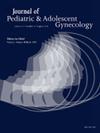40. Feasibility of Nurse Practitioner Led Vaginal Dilation Therapy: A Retrospective Cohort Study
IF 1.7
4区 医学
Q3 OBSTETRICS & GYNECOLOGY
引用次数: 0
Abstract
Background
Vaginal dilator therapy is the recommended first line management in patients with vaginal agenesis to increase vaginal length and improve sexual function and has been demonstrated to be highly effective with minimal risks. A barrier to successful vaginal dilator therapy is the long-term nature of treatment and the requirement for extended follow up over multiple visits. Nurse practitioner led clinics have been shown to have positive clinical outcomes in other disciplines, and use of a multidisciplinary clinic has been shown have an 88% functional success rate in patients undergoing vaginal dilator therapy. Our objective was to assess if nurse practitioner led vaginal dilator therapy is a feasible alternative to pediatric gynecologist led therapy and create an evidence-based model of care.
Methods
This is a retrospective cohort study. Electronic medical records were searched using the ICD codes for vaginal agenesis and uterine agenesis. Patients were included who had participated in vaginal dilator therapy led by a pediatric gynecologist or by a nurse practitioner at our institution's Women's Health Clinic. The primary outcomes were patient satisfaction, change in vaginal length, and sexual function throughout treatment. We also collected visit details including number and timing of visits, prescribed dilation schedule. This study was approved by the Research Ethics Board.
Results
Thirteen patients were included ranging from 15 to 33 years of age. The most common diagnosis was MRKH (92%). 92% of patients were recorded as unsatisfied with their sexual activity and vaginal length before treatment. Among patients who were seen by a nurse practitioner in association with pediatric gynecology, 80% reported normal sexual function, normal vaginal length, or overall satisfaction with vaginal dilator therapy at time of discharge. This is comparable to 84.6% of patients who were followed by either a nurse practitioner or pediatric gynecology alone. Patients were followed for a mean of 15.6 months and required a mean of 4.7 visits prior to discharge. Optimal spacing between visits was monthly with a prescribed dilation schedule of one to two times per day for 10 minutes at a time.
Conclusions
Nurse practitioner led vaginal dilator therapy is a comparable alternative to pediatric gynecology led therapy with similar outcomes as previously reported in the literature. This is a reasonable option to increase access to care for patients with vaginal agenesis without requiring routine specialist involvement.
40. 执业护士主导阴道扩张治疗的可行性:一项回顾性队列研究
阴道扩张器治疗是阴道发育不全患者推荐的一线治疗方法,以增加阴道长度和改善性功能,并且已被证明是非常有效且风险最小的治疗方法。阴道扩张器治疗成功的一个障碍是治疗的长期性和需要在多次访问中延长随访时间。由执业护士领导的诊所已被证明在其他学科中具有积极的临床结果,并且在接受阴道扩张器治疗的患者中,使用多学科诊所已被证明具有88%的功能成功率。我们的目的是评估护士领导的阴道扩张器治疗是否可以替代儿科妇科医生领导的治疗,并创建一个循证的护理模式。方法回顾性队列研究。使用ICD代码检索阴道发育不全和子宫发育不全的电子病历。患者参与了阴道扩张器治疗,由儿科妇科医生或我们机构妇女健康诊所的执业护士领导。主要结果是患者满意度、阴道长度的变化和整个治疗过程中的性功能。我们还收集了访问的详细信息,包括访问的次数和时间,规定的扩张时间表。本研究已获得研究伦理委员会的批准。结果入选患者13例,年龄15 ~ 33岁。最常见的诊断是MRKH(92%)。92%的患者在治疗前对性活动和阴道长度不满意。在与儿科妇科相关的执业护士看过的患者中,80%的患者在出院时报告性功能正常,阴道长度正常,或对阴道扩张器治疗总体满意。这与仅由执业护士或儿科妇科医生随访的患者的84.6%相当。患者平均随访15.6个月,出院前平均就诊4.7次。最佳访问间隔是每月一次,规定的扩张计划为每天一到两次,每次10分钟。结论护士主导的阴道扩张器治疗是一种与儿科妇科主导的治疗方法相当的替代方法,其结果与文献中报道的相似。这是一个合理的选择,以增加获得护理的患者阴道发育不全,而不需要常规的专家参与。
本文章由计算机程序翻译,如有差异,请以英文原文为准。
求助全文
约1分钟内获得全文
求助全文
来源期刊
CiteScore
3.90
自引率
11.10%
发文量
251
审稿时长
57 days
期刊介绍:
Journal of Pediatric and Adolescent Gynecology includes all aspects of clinical and basic science research in pediatric and adolescent gynecology. The Journal draws on expertise from a variety of disciplines including pediatrics, obstetrics and gynecology, reproduction and gynecology, reproductive and pediatric endocrinology, genetics, and molecular biology.
The Journal of Pediatric and Adolescent Gynecology features original studies, review articles, book and literature reviews, letters to the editor, and communications in brief. It is an essential resource for the libraries of OB/GYN specialists, as well as pediatricians and primary care physicians.

 求助内容:
求助内容: 应助结果提醒方式:
应助结果提醒方式:


